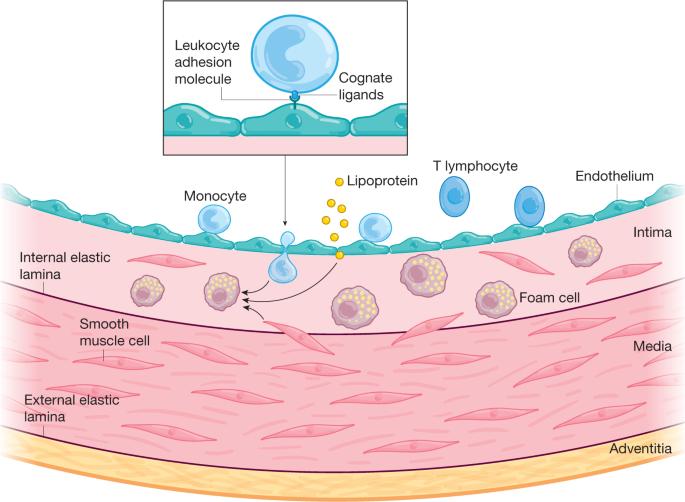不断变化的动脉粥样硬化状况
IF 48.5
1区 综合性期刊
Q1 MULTIDISCIPLINARY SCIENCES
引用次数: 625
摘要
新出现的证据促使与动脉粥样硬化有关的概念发生了很大的变化,并对以前的许多观念提出了质疑。在此,我将回顾这些证据,并讨论其对理解动脉粥样硬化的影响。罹患动脉粥样硬化的风险不再集中在西方国家,相反,它与全球大多数死亡有关。与以前相比,动脉粥样硬化现在影响着更年轻的人群、更多的女性和来自不同种族背景的个人。随着低密度脂蛋白(LDL)胆固醇、血压和吸烟水平的下降,风险因素也发生了变化。最近的研究对高密度脂蛋白的保护作用提出了质疑,现在除低密度脂蛋白外,还关注富含甘油三酯的脂蛋白对动脉粥样硬化的影响。动脉粥样硬化的非传统驱动因素--如睡眠紊乱、缺乏运动、微生物组、空气污染和环境压力--也受到了关注。炎症途径和白细胞将传统的和新出现的风险因素与动脉壁细胞行为的改变联系在一起。对动脉粥样硬化发病机制的研究突出了骨髓的作用:干细胞中的体细胞突变可导致克隆性造血,这是一种以前未被认识到但却常见的、与年龄有关的心血管疾病风险诱因。对动脉粥样硬化血栓并发症机理的描述已经超越了 "易损斑块 "的概念。我们对动脉粥样硬化生物学认识的这些进展为治疗干预开辟了道路,有望改善目前普遍存在的动脉粥样硬化疾病的预防和治疗。本综述讨论了改变我们对动脉粥样硬化生物学认识的最新研究,并探讨了这些研究对治疗动脉粥样硬化性心血管疾病的影响。本文章由计算机程序翻译,如有差异,请以英文原文为准。

The changing landscape of atherosclerosis
Emerging evidence has spurred a considerable evolution of concepts relating to atherosclerosis, and has called into question many previous notions. Here I review this evidence, and discuss its implications for understanding of atherosclerosis. The risk of developing atherosclerosis is no longer concentrated in Western countries, and it is instead involved in the majority of deaths worldwide. Atherosclerosis now affects younger people, and more women and individuals from a diverse range of ethnic backgrounds, than was formerly the case. The risk factor profile has shifted as levels of low-density lipoprotein (LDL) cholesterol, blood pressure and smoking have decreased. Recent research has challenged the protective effects of high-density lipoprotein, and now focuses on triglyceride-rich lipoproteins in addition to low-density lipoprotein as causal in atherosclerosis. Non-traditional drivers of atherosclerosis—such as disturbed sleep, physical inactivity, the microbiome, air pollution and environmental stress—have also gained attention. Inflammatory pathways and leukocytes link traditional and emerging risk factors alike to the altered behaviour of arterial wall cells. Probing the pathogenesis of atherosclerosis has highlighted the role of the bone marrow: somatic mutations in stem cells can cause clonal haematopoiesis, which represents a previously unrecognized but common and potent age-related contributor to the risk of developing cardiovascular disease. Characterizations of the mechanisms that underpin thrombotic complications of atherosclerosis have evolved beyond the ‘vulnerable plaque’ concept. These advances in our understanding of the biology of atherosclerosis have opened avenues to therapeutic interventions that promise to improve the prevention and treatment of now-ubiquitous atherosclerotic diseases. This Review discusses recent research that has transformed our understanding of the biology of atherosclerosis, and examines its implications for the treatment of atherosclerotic cardiovascular disease.
求助全文
通过发布文献求助,成功后即可免费获取论文全文。
去求助
来源期刊

Nature
综合性期刊-综合性期刊
CiteScore
90.00
自引率
1.20%
发文量
3652
审稿时长
3 months
期刊介绍:
Nature is a prestigious international journal that publishes peer-reviewed research in various scientific and technological fields. The selection of articles is based on criteria such as originality, importance, interdisciplinary relevance, timeliness, accessibility, elegance, and surprising conclusions. In addition to showcasing significant scientific advances, Nature delivers rapid, authoritative, insightful news, and interpretation of current and upcoming trends impacting science, scientists, and the broader public. The journal serves a dual purpose: firstly, to promptly share noteworthy scientific advances and foster discussions among scientists, and secondly, to ensure the swift dissemination of scientific results globally, emphasizing their significance for knowledge, culture, and daily life.
 求助内容:
求助内容: 应助结果提醒方式:
应助结果提醒方式:


